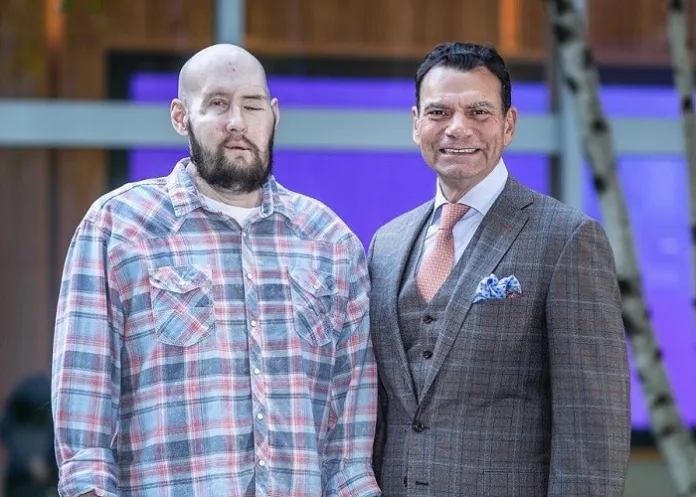American surgeons have performed the world’s first transplant of an entire human eye, an extraordinary addition to a face transplant – although it’s too soon to know if the man will ever see through his new left eye.
On 27 May, Dr Eduardo Rodriguez at NYU Langone Health in New York and a team of more than 140 others, performed the eye transplant alongside a partial face transplant in Aaron James, a 46-year-old power line worker from Arkansas. To date, fewer than 50 facial transplants have been performed and none included an eye.
An accident with high-voltage power lines had destroyed most of James’ face and one eye. His right eye still works. But the surgeons hoped that replacing the missing one would yield better cosmetic results for his new face, by supporting the transplanted eye socket and lid, reports The Guardian.
Last week, the team announced that so far, it’s doing just that. James is recovering well from the dual transplant and the donated eye looks remarkably healthy.
“It feels good. I still don’t have any movement in it yet. My eyelid, I can’t blink yet. But I’m getting sensation now,” James said.
Today, transplants of the cornea – the clear tissue in front of the eye – are common to treat certain types of vision loss. But transplanting the whole eye – the eyeball, its blood supply and the critical optic nerve that must connect it to the brain – is considered a moonshot in the quest to cure blindness.
Whatever happens next, James’ surgery offers scientists an unprecedented window into how the human eye tries to heal.
“We’re not claiming that we are going to restore sight,” said Rodriguez, NYU’s plastic surgery chief, who led the transplant. “But there’s no doubt in my mind we are one step closer.”
Intricate process
Rodriguez and his team transferred the nose, lips and bone segments underlying the left cheek and chin of a deceased donor to James, along with most of the tissue beneath the right eye. They also transferred the donor’s entire left eye including the eyelids, eyebrows and eye socket.
New Scientist reports that the procedure lasted about 21 hours.
The first challenge was extracting the intricate network of blood vessels surrounding the eyeball. Unlike other facial features, the eye receives blood from the brain region directly behind the eyeball. So the surgeons had to partially remove the donor’s skull to access these vessels.
To avoid having to remove part of James’ skull too – which would have meant operating near his brain – the surgeons connected the vessels to others in the donor’s face. This allowed the team to re-establish blood flow to the eye within 25 minutes of the surgical procedure and bypass the brain.
Then later, during the transplant itself, they connected these vessels to some in James’ neck.
Removing the donor’s skull also gave surgeons better access to the optic nerve. This bundle of nerve fibres transmits information from the eye to the brain, enabling us to see.
Doctors have never successfully reconnected a severed optic nerve. In an attempt to do so, Rodriguez and his team preserved as much of the donor optic nerve’s length as possible. This, they reasoned, would maximise the chances of the nerve fibres regenerating and establishing a connection with James’s brain.
They also took stem cells – which can develop into different types of specialist cells – from the donor’s bone marrow, and injected them into the site where the donor optic nerve and James’ optic nerve met, to further stimulate nerve growth.
More than five months after the surgical procedure, the eyeball appears to be healthy. It has sufficient blood flow and internal fluid pressure and can produce tears. Some of the nerve cells critical for sight are also alive, though James is unable to see using the eye and might never be able to do so, says Rodriguez.
Some specialists had feared the eye would quickly shrivel like a raisin. Instead, when Rodriguez propped open James’ left eyelid last month, the donated hazel-coloured eye was as plump and full of fluid as his own blue eye. Doctors see good blood flow and no sign of rejection.
Now researchers have begun analysing scans of James’ brain that detected some puzzling signals from that all-important but injured optic nerve.
One scientist who has long studied how to make eye transplants a reality called the surgery exciting.
“It’s an amazing validation of animal experiments that have kept transplanted eyes alive,” said Dr Jeffrey Goldberg, chair of ophthalmology at California’s Stanford University.
The hurdle is how to regrow the optic nerve, although animal studies are making strides, Goldberg added. He praised the NYU team’s “audacity” in even aiming for optic nerve repair and hopes the transplant will spur more research.
“We’re really on the precipice of being able to do this,” he said.
James nearly died after being shocked in the power line accident in June 2021. Ultimately he lost his left arm, requiring a prosthetic.
His damaged left eye was so painful it had to be removed. Multiple reconstructive surgeries couldn’t repair extensive facial injuries including his missing nose and lips.
He had pushed through physical therapy, wearing a face mask and eye patch. Still he required breathing and feeding tubes, and longed to smell, taste and eat solid food again.
“In his mind and his heart, it’s him – so I didn’t care that, you know, he didn’t have a nose. But I did care that it bothered him,” said his wife, Meagan James.
Face transplants remain rare and risky. James’ is only the 19th in the US.
New Scientist article – Human eyeball successfully transplanted for the first time (Open access)
See more from MedicalBrief archives:
Man recovering after ground-breaking second face transplant
Bioengineered pig-skin cornea restores sight, treats keratoconus – Swedish study
Five-year outcomes for face transplant recipients
Study finds corneal donor tissue can be safely stored for longer

